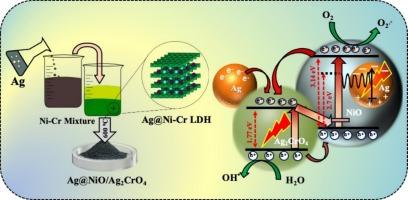Advanced LDH-derived Ag@NiO/Ag2CrO4 heterojunction photocatalyst for rapid dye degradation
IF 6.7
2区 工程技术
Q1 ENGINEERING, CHEMICAL
引用次数: 0
Abstract
This work unveils a superior plasmonic photocatalyst synthesized through the strategic integration of metallic Ag during Ni![]() Cr LDH synthesis. The catalyst synthesis involved the formation of modified Ni
Cr LDH synthesis. The catalyst synthesis involved the formation of modified Ni![]() Cr LDH, by the incorporation of a metallic Ag solution and subsequent air heat treatment, leading to the in-situ development of the mixed metal oxide Ag@NiO/Ag2CrO4 (ANC). The ANC photocatalyst exhibits strong visible-light absorption and suitably positioned band edges, forming a Z-scheme heterojunction that facilitates efficient charge transfer and enhances redox reactivity. The efficacy of the photocatalyst was evaluated by the degradation of MB and RhB dye, revealing that the heterojunction photocatalyst outperformed the LDH derived NiO (NC) counterpart by 34 fold and 1.4 fold in MB and RhB degradation, respectively. The improved catalytic performance mainly stems from its efficient harvesting of visible light, and the plasmonic effects, including local surface plasmon resonance (LSPR) and plasmon induced resonant energy transfer (PIRET). The PIRET phenomena enabled by Ag nanoparticles plays a crucial intermediary role in sustaining an efficient Z-scheme charge transfer between Ag2CrO4 and NiO. The key significance of this study lies in its innovative synthesis strategy, wherein Ni
Cr LDH, by the incorporation of a metallic Ag solution and subsequent air heat treatment, leading to the in-situ development of the mixed metal oxide Ag@NiO/Ag2CrO4 (ANC). The ANC photocatalyst exhibits strong visible-light absorption and suitably positioned band edges, forming a Z-scheme heterojunction that facilitates efficient charge transfer and enhances redox reactivity. The efficacy of the photocatalyst was evaluated by the degradation of MB and RhB dye, revealing that the heterojunction photocatalyst outperformed the LDH derived NiO (NC) counterpart by 34 fold and 1.4 fold in MB and RhB degradation, respectively. The improved catalytic performance mainly stems from its efficient harvesting of visible light, and the plasmonic effects, including local surface plasmon resonance (LSPR) and plasmon induced resonant energy transfer (PIRET). The PIRET phenomena enabled by Ag nanoparticles plays a crucial intermediary role in sustaining an efficient Z-scheme charge transfer between Ag2CrO4 and NiO. The key significance of this study lies in its innovative synthesis strategy, wherein Ni![]() Cr LDH serves as a transformative precursor, strategically engineered to develop highly active photocatalysts through the incorporation of plasmonic Ag.
Cr LDH serves as a transformative precursor, strategically engineered to develop highly active photocatalysts through the incorporation of plasmonic Ag.

先进的ldh衍生Ag@NiO/Ag2CrO4异质结光催化剂用于染料的快速降解
这项工作揭示了一种优越的等离子体光催化剂,通过在NiCr LDH合成过程中战略性地整合金属银合成。催化剂的合成包括通过加入金属Ag溶液和随后的空气热处理来形成改性的NiCr LDH,从而导致原位发展的混合金属氧化物Ag@NiO/Ag2CrO4 (ANC)。ANC光催化剂具有很强的可见光吸收能力和合适的带边位置,形成z型异质结,有利于有效的电荷转移和增强氧化还原反应性。通过对MB和RhB染料的降解效果进行了评价,结果表明,异质结光催化剂对MB和RhB的降解效果分别是LDH衍生NiO (NC)的34倍和1.4倍。催化性能的提高主要源于其对可见光的有效捕获,以及等离子体效应,包括局部表面等离子体共振(LSPR)和等离子体诱导共振能量转移(PIRET)。Ag纳米粒子激活的PIRET现象在维持Ag2CrO4和NiO之间有效的Z-scheme电荷转移中起着至关重要的中介作用。本研究的关键意义在于其创新的合成策略,其中NiCr LDH作为转化前体,通过结合等离子体Ag战略性地设计以开发高活性光催化剂。
本文章由计算机程序翻译,如有差异,请以英文原文为准。
求助全文
约1分钟内获得全文
求助全文
来源期刊

Journal of water process engineering
Biochemistry, Genetics and Molecular Biology-Biotechnology
CiteScore
10.70
自引率
8.60%
发文量
846
审稿时长
24 days
期刊介绍:
The Journal of Water Process Engineering aims to publish refereed, high-quality research papers with significant novelty and impact in all areas of the engineering of water and wastewater processing . Papers on advanced and novel treatment processes and technologies are particularly welcome. The Journal considers papers in areas such as nanotechnology and biotechnology applications in water, novel oxidation and separation processes, membrane processes (except those for desalination) , catalytic processes for the removal of water contaminants, sustainable processes, water reuse and recycling, water use and wastewater minimization, integrated/hybrid technology, process modeling of water treatment and novel treatment processes. Submissions on the subject of adsorbents, including standard measurements of adsorption kinetics and equilibrium will only be considered if there is a genuine case for novelty and contribution, for example highly novel, sustainable adsorbents and their use: papers on activated carbon-type materials derived from natural matter, or surfactant-modified clays and related minerals, would not fulfil this criterion. The Journal particularly welcomes contributions involving environmentally, economically and socially sustainable technology for water treatment, including those which are energy-efficient, with minimal or no chemical consumption, and capable of water recycling and reuse that minimizes the direct disposal of wastewater to the aquatic environment. Papers that describe novel ideas for solving issues related to water quality and availability are also welcome, as are those that show the transfer of techniques from other disciplines. The Journal will consider papers dealing with processes for various water matrices including drinking water (except desalination), domestic, urban and industrial wastewaters, in addition to their residues. It is expected that the journal will be of particular relevance to chemical and process engineers working in the field. The Journal welcomes Full Text papers, Short Communications, State-of-the-Art Reviews and Letters to Editors and Case Studies
 求助内容:
求助内容: 应助结果提醒方式:
应助结果提醒方式:


